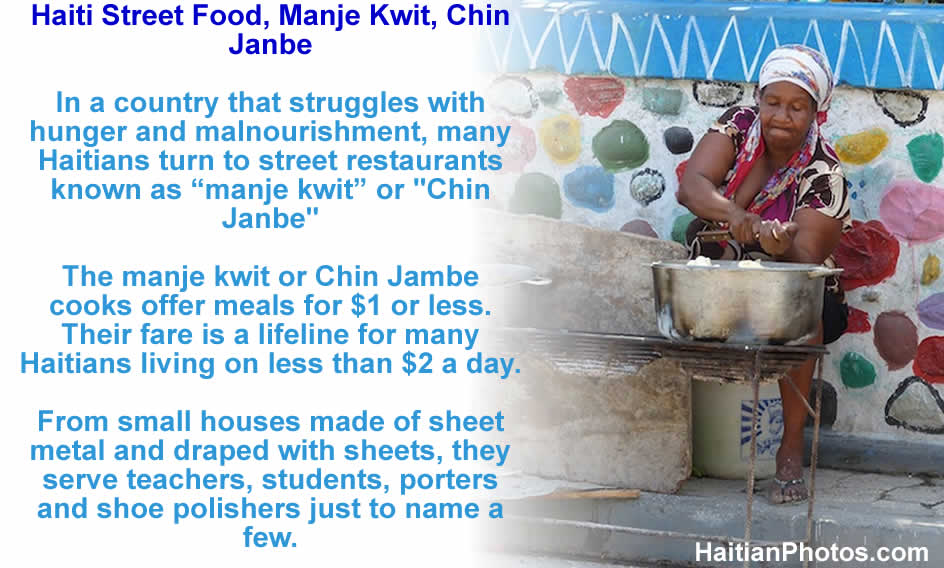ADVERTISEMENT

Haiti Street Food, manje kwit or Chin Janbe, for $1 or less
In a country that struggles with hunger and malnourishment, many Haitians turn to the informal street restaurants known as "manje kwit" or "Chin Janbe" that line many of the city's major streets.
The manje kwit or Chin Jambe cooks offer meals for $1 or less. Their fare is a lifeline for many Haitians living on less than $2 a day.
From small houses made of sheet metal and draped with sheets, they serve teachers, students, porters and shoe polishers just to name a few.
If you have visited Haiti but never tasted their street food, your exploration is yet incomplete. You can identify over one hundred and fifty street food items in the informal street restaurants that line many of the city's major streets. Haitian foods are a blend of influences. Creole cuisine originates from a blend of several culinary styles that populated the western portion of the island of Hispaniola, namely the French, African, Taíno natives, and Spanish influence. Mixed roots and spices, basic yet zippy, simple and grounded by the reality of the tropics and the back-story of its African heritage, yet touched with a hint of French complexity. Street food is comparatively a new concept in Haiti. Vendors sit under umbrellas on every Port-au-Prince sidewalk peddling fare like fried plantains, chicken, and spaghetti. Some enterprising Haitians, however, are consciously taking a cue from food truck scenes abroad and adding their own Creole twist.
Haitian Street Food Sellers are known as 'Chin Janbe'--they are the lifeline for many of the capital's food-insecure resident. The street food venders are simple poor men who prepare food in their small houses and shanties. Some of them are great chefs who sell their foods in the stalls near bus stations, churches or on the edges of local markets and serve local people at an affordable price like 75 gourdes ($1) or less, while the average cost of a plate of food in basic Creole restaurants here is 250 Haitian gourdes ($4). Haiti is one of the poorest countries in the Western Hemisphere, where most citizens live on less than $2 a day.
In early July when protests against price hikes paralyzed Port-au-Prince, these informal street chefs known as "manje kwit, without prior notice, were forced close their stalls. They could not sell their prepared foods. Whatever they had, had to share within the family and rest distributed free to their neighbors. Thus, they lost a major part of their savings cum investment in a single day. During the five days of protest, many of their poor clients struggled to find food which they can afford to buy.
Read more about Food, haitian food, street, haiti streets, Community Restaurant, newsletter, Food Aid, Haitian Restaurant, chin jambe, Food

 Bouki Ak Ti Malice, Story Of Intelligence Vs Ignorance For...
Bouki Ak Ti Malice, Story Of Intelligence Vs Ignorance For...  Haitian protesters called on Russian President Vladimir Putin...
Haitian protesters called on Russian President Vladimir Putin...  Jounalis Phares Duverne mouri
Jounalis Phares Duverne mouri  Paul Eugène Magloire, born in Quartier Morin
Paul Eugène Magloire, born in Quartier Morin  Dr. Michaëlle Amédée Gédéon is dead
Dr. Michaëlle Amédée Gédéon is dead  Philippe Vorbe entered world football Hall of Fame, CONCACAF
Philippe Vorbe entered world football Hall of Fame, CONCACAF  Jovenel Moïse nominated Jean Henry Céant as prime minister of...
Jovenel Moïse nominated Jean Henry Céant as prime minister of...  Haitians, the second largest black immigrant group in the US
Haitians, the second largest black immigrant group in the US 



